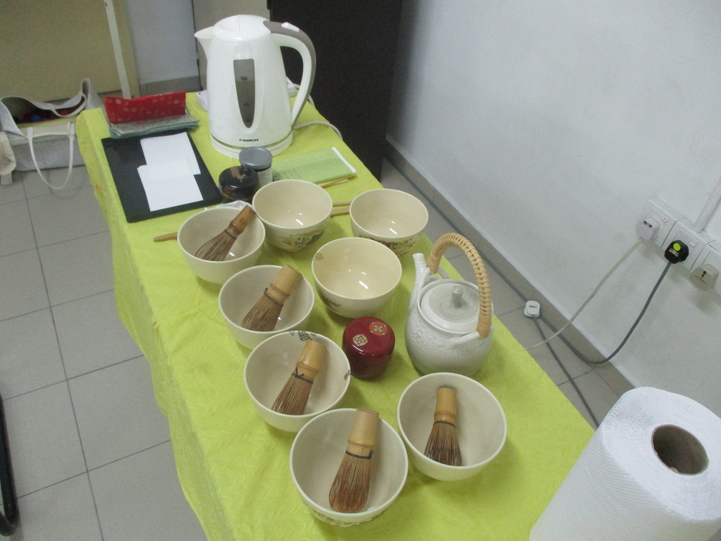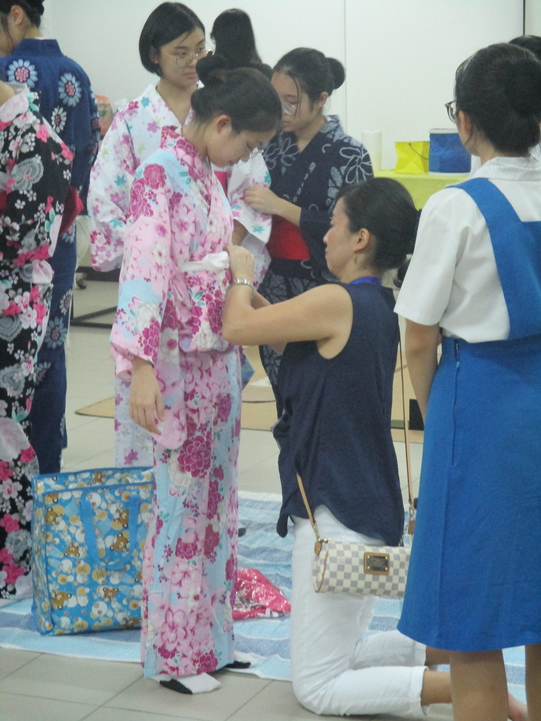By:
Ng Choon Hau (Sr1A)
Isn’t Japanese culture lovely? From the exquisite paintings to the fancy kimonos, it’s no wonder that people all over the globe are crazy for Japanese culture. Given that Japanese culture is at this peak of popularity, it just felt right for the Japanese Language Club to hold a Japanese Tea Ceremony workshop. It was held at AV2 after school on Thursday, 25 July 2019 with a registration fee of RM10.
There were altogether 6 mentors from an external Japan Club in Kuala Lumpur came to conduct the workshop. They have been doing this for our school club for the past eight years; Japanese culture is what they prize the most.
The workshop started around a quarter past 3 in the afternoon with everyone putting on their floral kimonos. The mentors and Japanese Club members helped out in the wearing of these traditional garments. One can see a few mats laid out for the ceremony to take place. In the corner of the room, you can see a table with treats and tea things, like bowls, whisks and tea powder, laid out in preparation for tea making. The oriental music playing in the background perfectly complements the fun atmosphere of everyone wearing the kimonos.
Afterwards, everyone sat down in the seiza (formal Japanese sitting posture) position on the various mats. One of the elderly mentors, seated in the middle of the room, initiated the tea ceremony with a cleansing ritual. Then, she added some tea powder into the bowl with a piece of bamboo shaped to look like a spoon. This followed with the addition of hot water and the whisking of the mixture with a bamboo whisk till bubbles formed. And, voila! A cup of traditional Japanese tea was made. Students participated attentively throughout the entire process while Japanese club members made the briefing.
 |
 |
 |
 |
A treat (wagashi) was served for all the students for them to eat so that they will leave a sweet taste in their mouth before consuming the somewhat bitter tea. Before consuming the treat, students will have to say osakini (pardon me for going ahead of you) to the student beside them. Following that, Japanese club members will hand the students their bowl of tea while students thank them with saying otemae chodai itashimasu (thank you for making tea). Students will then have to face the side of the bowl with the emblem towards themselves and rotate the bowl thrice so that the emblem faces outwards. Then, they have to rotate the bowl thrice again but in the opposite direction so that the emblem faces them. Then, they can gulp down the tea and finish the ceremony.
If that sounds needlessly complicated to you, you wouldn’t live through the real thing since this workshop provides a simplified version of the actual ceremony to save time.
After everyone was done with their tea, photography club members, student reporters and the teacher there were invited to partake in this ceremony. Students who wanted to experience the ceremony again could sit down on the mat again. If they wanted to make some tea for themselves, they could head on over to the table in the corner.
At around 4:30 p.m., the Japanese exchange students from Tokyo Jogakkan High School came in to witness the ceremony wrap up with everyone in kimonos lining up for a group picture. They weren’t interested in the ceremony, though – they were more interested in the bamboo hanging in the corner. This workshop ended at 4:45 p.m. where participants and Japanese club members alike helped with cleanup.
Overall, this workshop was a smashing success. Although the original reception was lacking, they still managed to produce a lively atmosphere with people leaving happily. The mentors and Japanese club members were also satisfied with the cooperation the students showed in the workshop, since everyone took this really seriously and no one goofed off. Speaking from personal experience, this workshop really is a must try for everyone; though fair warning, your legs will hate you after this. Here’s to hoping that this annual Japanese club tradition may live on for many years to come!
 |
 |

